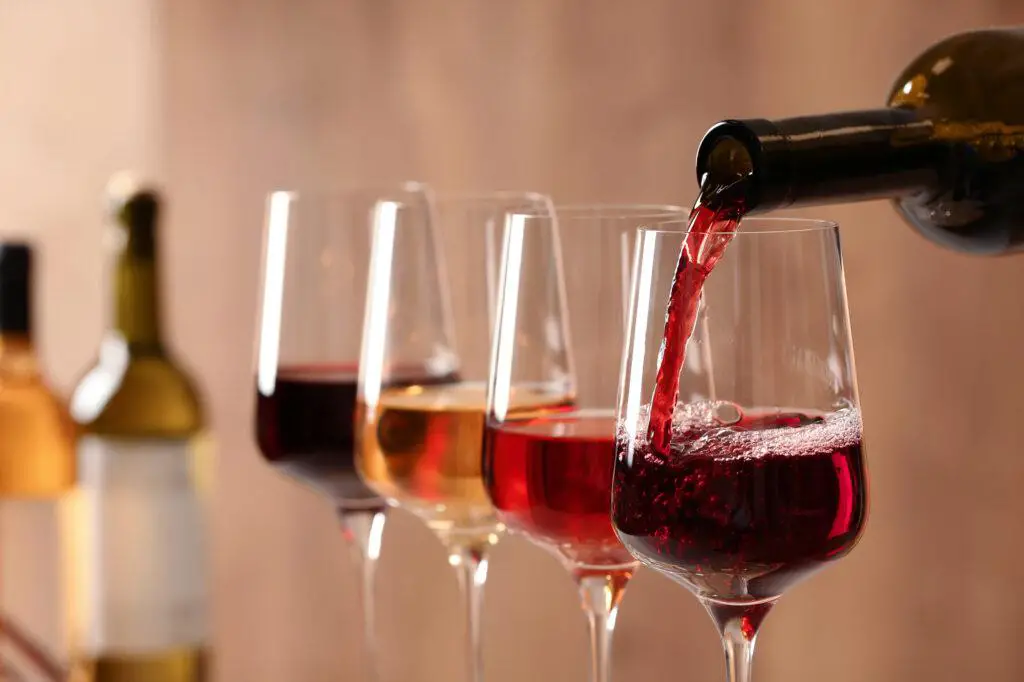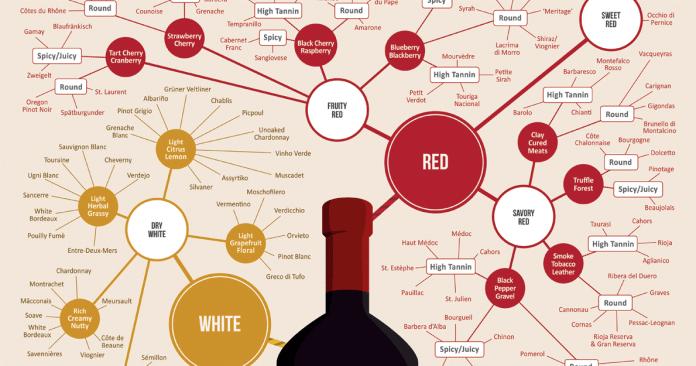Classification of Wines or Types of wines
Still Wines
- This is the largest category in the Classification of Wines. The alcoholic strength may be between 9% and 15% by volume. The wines may be:
- Red: being fermented in contact with grape skins from which the wine gets its colour. Normally dry wines.
- White: usually produced from white grapes, but the grape juice (must) is usually fermented away from the skins. Normally dry to very sweet.
- Rose: made in three ways – from red grapes fermented on the skins for up to 48 hours; by mixing red and white wines together; or by pressing grapes so that some colour is extracted.
- It may be dry or semi-sweet. These are called blush wines in the USA when made wholly from red grapes.
Sparkling Wines
- The most famous is Champagne. This is made by the methode champenoise (secondary fermentation in the bottle) in an area of north-eastern France.
- Effervescent wines made outside this area are called vins mousseux or sparkling wines and are made by either the methode champenoise (now to be called methode traditionelle), the Charmat method (tank fermented and sometimes termed the methode cuve close), the transfer method, or the carbonation method.
- They may vary from brut (very dry), sec (medium dry), demi-sec (medium sweet), to doux (sweet).
Fortified Wines
- Fortified wines such as Sherry, Port and Madeira have been strengthened by the addition of alcohol, usually a grape spirit.
- These are now known within the EC as liqueur wines or vins de liqueur. Their alcoholic strength may be between 15% and 22%, by volume.
- Sherry (from Spain) 15-18% ; made from white grapes -fino (dry), amontillado (medium), oloroso (sweet)
- Port (from Portugal) 18-22% ; strong sweet; typically drunk as a dessert wine – ruby, tawny, vintage character, late bottled vintage, vintage
- Madeira 18% (famous dessert wine; made on the Portuguese island of Madeira) – Sercial (dry), Verdelho (medium), Bual (sweet), Malmsey (very sweet)
- Marsala 18% – a dark sweet wine from Marsala in Sicily
Aromatised Wines
- An aromatised wine must have a minimum alcohol content of 14.5% by volume and a maximum alcohol content of 22% by volume according to EU law Council Regulation (EEC)
- The majority of older brands come from France and Italy but there are now a range of small ‘craft’ producers around the world.
Vinification

The process central to vinification (wine making) is fermentation – the conversion of sugar by yeast to alcohol and carbon dioxide.
This process is also necessary to the making of all alcoholic beverages – not only for still, sparkling and fortified wines, but also spirits, liqueurs and beers (although some variations and further processes will be applied for different types of beverages).





indian pharmacy paypal https://indiaph24.store/# india online pharmacy
Online medicine home delivery
mexico drug stores pharmacies: Online Pharmacies in Mexico – best online pharmacies in mexico
best india pharmacy [url=https://indiaph24.store/#]Cheapest online pharmacy[/url] п»їlegitimate online pharmacies india
http://canadaph24.pro/# canadian pharmacy online
https://lisinopril.network/# where to buy lisinopril 2.5 mg
http://finasteride.store/# generic propecia no prescription
https://lisinopril.network/# cheapest price for lisinopril
buy cipro cheap [url=https://ciprofloxacin.tech/#]ciprofloxacin[/url] cipro for sale
alternative to tamoxifen: buy nolvadex online – does tamoxifen make you tired
ciprofloxacin order online [url=http://ciprofloxacin.tech/#]ciprofloxacin over the counter[/url] cipro for sale
https://cytotec.club/# Misoprostol 200 mg buy online
cipro ciprofloxacin: buy generic ciprofloxacin – ciprofloxacin mail online
https://finasteride.store/# buy cheap propecia without rx
lisinopril 2.5 pill [url=https://lisinopril.network/#]lisinopril 40 mg canada[/url] lisinopril 3972
http://ciprofloxacin.tech/# buy cipro online without prescription
https://nolvadex.life/# tamoxifen endometrium
buying propecia price: cost of cheap propecia pill – buy propecia prices
http://ciprofloxacin.tech/# cipro for sale
http://ciprofloxacin.tech/# buy ciprofloxacin over the counter
order cheap lisinopril [url=https://lisinopril.network/#]lisinopril for sale[/url] cost of lisinopril 40 mg
lisinopril 10 mg canada cost [url=http://lisinopril.network/#]prinivil lisinopril[/url] lisinopril 10 mg online
order cytotec online: buy cytotec online fast delivery – cytotec pills online
http://cytotec.club/# buy cytotec pills
http://lisinopril.network/# lisinopril cost uk
ciprofloxacin 500mg buy online: ciprofloxacin generic – buy cipro online canada
http://finasteride.store/# order propecia pills
purchase cytotec [url=https://cytotec.club/#]cytotec abortion pill[/url] buy cytotec in usa
ciprofloxacin 500 mg tablet price: ciprofloxacin mail online – cipro generic
https://finasteride.store/# cost cheap propecia without prescription
tamoxifen reviews [url=http://nolvadex.life/#]aromatase inhibitors tamoxifen[/url] tamoxifen and grapefruit
ciprofloxacin generic price [url=http://ciprofloxacin.tech/#]ciprofloxacin mail online[/url] cipro 500mg best prices
https://lisinopril.network/# lisinopril 20mg india
http://ciprofloxacin.tech/# buy cipro online without prescription
what is tamoxifen used for: tamoxifen for gynecomastia reviews – does tamoxifen cause menopause
femara vs tamoxifen [url=https://nolvadex.life/#]nolvadex pills[/url] benefits of tamoxifen
http://cytotec.club/# buy misoprostol over the counter
benefits of tamoxifen [url=https://nolvadex.life/#]nolvadex generic[/url] tamoxifen hormone therapy
Misoprostol 200 mg buy online: purchase cytotec – cytotec buy online usa
http://lisinopril.network/# zestril tablet price
http://lisinopril.network/# lisinopril 20 mg canada
buy lisinopril without prescription [url=http://lisinopril.network/#]lisinopril 60 mg daily[/url] lisinopril 1 mg tablet
zestoretic 20 25 mg [url=http://lisinopril.network/#]lisinopril tabs 10mg[/url] zestril 10mg price
cytotec buy online usa: Cytotec 200mcg price – Abortion pills online
https://lisinopril.network/# lisinopril 10mg tablet
https://ciprofloxacin.tech/# antibiotics cipro
buying cheap propecia without rx [url=https://finasteride.store/#]order cheap propecia tablets[/url] propecia pill
cytotec online: cytotec buy online usa – Cytotec 200mcg price
http://ciprofloxacin.tech/# ciprofloxacin generic
buying generic propecia pill [url=https://finasteride.store/#]propecia generics[/url] propecia cost
http://cenforce.pro/# order cenforce
sildenafil oral jelly 100mg kamagra: kamagra – Kamagra 100mg
Cheap generic Viagra [url=https://viagras.online/#]Buy Viagra online cheap[/url] Generic Viagra online
Levitra price: Buy generic Levitra online – Levitra tablet price
Cheap Cialis [url=https://cialist.pro/#]cialist.pro[/url] cheapest cialis
http://viagras.online/# over the counter sildenafil
Cialis over the counter: Generic Tadalafil 20mg price – Buy Cialis online
https://kamagra.win/# buy Kamagra
Cheap Levitra online: Levitra 20mg price – Buy Vardenafil online
Buy Tadalafil 10mg: buy cialis overseas – Cialis over the counter
https://cenforce.pro/# order cenforce
Kamagra tablets [url=http://kamagra.win/#]kamagra[/url] cheap kamagra
https://viagras.online/# Cheapest Sildenafil online
https://kamagra.win/# Kamagra Oral Jelly
buy kamagra online usa: kamagra.win – buy Kamagra
Buy Vardenafil 20mg online [url=http://levitrav.store/#]Levitra generic price[/url] Vardenafil buy online
https://kamagra.win/# Kamagra Oral Jelly
cheapest cialis [url=http://cialist.pro/#]buy cialis overseas[/url] п»їcialis generic
Cheap Levitra online: Vardenafil online prescription – Vardenafil buy online
п»їLevitra price: Cheap Levitra online – Vardenafil buy online
https://viagras.online/# sildenafil over the counter
https://viagras.online/# buy Viagra online
http://pharmnoprescription.icu/# online pharmacies without prescription
pharmacies in mexico that ship to usa: mexican drugstore online – pharmacies in mexico that ship to usa
Online medicine order [url=https://pharmindia.online/#]pharmacy website india[/url] best online pharmacy india
international pharmacy no prescription: pharm world store – mail order prescription drugs from canada
pharmacies in mexico that ship to usa [url=https://pharmmexico.online/#]п»їbest mexican online pharmacies[/url] mexican rx online
buy prescription online: prescription online canada – buy medication online no prescription
indian pharmacy paypal: online shopping pharmacy india – indian pharmacy paypal
canadian online pharmacy no prescription: cheapest pharmacy – pharmacy coupons
pharmacies in mexico that ship to usa [url=http://pharmmexico.online/#]mexico pharmacies prescription drugs[/url] pharmacies in mexico that ship to usa
https://pharmworld.store/# pharmacy online 365 discount code
online pharmacy without prescription: prescription drugs online canada – pharmacy no prescription required
mexico drug stores pharmacies [url=http://pharmmexico.online/#]best online pharmacies in mexico[/url] mexican mail order pharmacies
http://pharmindia.online/# pharmacy website india
https://pharmindia.online/# india pharmacy
india online pharmacy: top 10 online pharmacy in india – online shopping pharmacy india
legit canadian pharmacy [url=http://pharmcanada.shop/#]canadian pharmacy scam[/url] reliable canadian pharmacy reviews